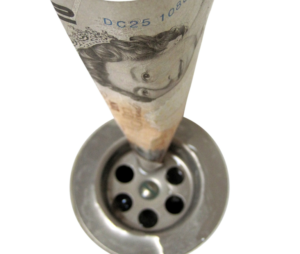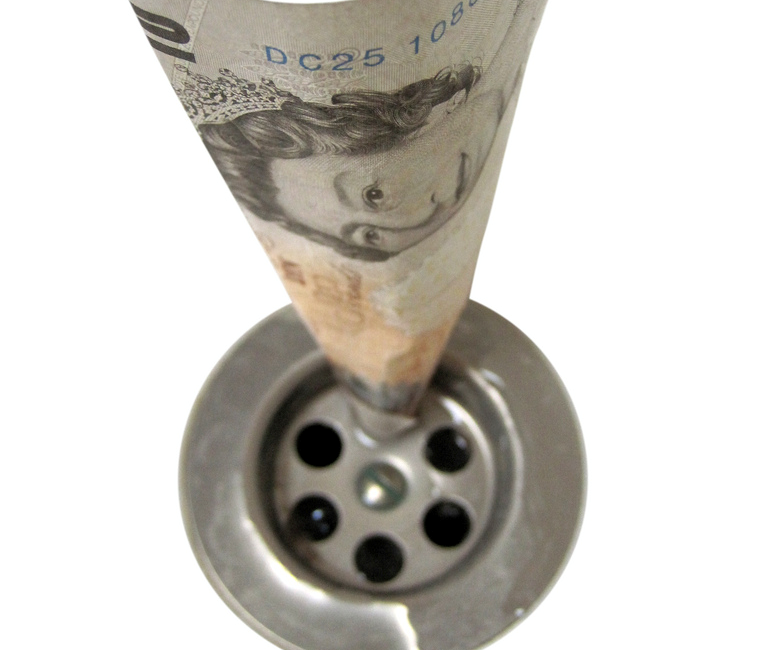27 September 2018
The Folly of Frugality
Saving has become futile.
By Frank O’Nomics
 Saving, conventional logic dictates, is nothing more than deferred consumption. We put a sum of money aside while we are earning so that, when we are not, we still have something to live on. Such logic is instilled in us at an early age, whether we are told the story of Joseph preparing for seven years of famine during seven years of plenty (Genesis 50:20 since you ask) or are given some cash for a “rainy day” by a relative. The logic all works perfectly until we factor in our old friend – inflation.
Saving, conventional logic dictates, is nothing more than deferred consumption. We put a sum of money aside while we are earning so that, when we are not, we still have something to live on. Such logic is instilled in us at an early age, whether we are told the story of Joseph preparing for seven years of famine during seven years of plenty (Genesis 50:20 since you ask) or are given some cash for a “rainy day” by a relative. The logic all works perfectly until we factor in our old friend – inflation.
For many years the rate of interest that we got on our savings was sufficient to cover the rate of inflation with a little extra on top to reward us for lending the money to our bank or building society. However, in recent years that relationship has broken down so that, following the recent rise in inflation to 2.7%, 99% of all savings products now fail to beat inflation. Logic would seem to dictate that we spend all that we earn so that we maximise the value of that money. Why defer that car or holiday when in a few years time the money will buy a Corsa rather than a Corniche, or a trip to Bognor rather than Bermuda? Clearly this does not make for a secure lifestyle, so what can we do?
The global financial crisis may have passed some time ago but it has left a long legacy on interest rates. The accommodative policies of central banks have kept rates at very low levels for a considerable period and, while we are finally seeing some rises in official rates in response to above target levels of inflation, the pace is glacial. Further, even though quantitative easing ended some time ago in the UK, there remains a great deal of available cash so that even the modest rises in base rates have little impact on the interest offered to savers. A lack of demand for money means leaving commercial banks under no obligation to pass on moves in official interest rates.
Looking at the various potential homes for our savings provides little solace. Not a single easy access account (including cash ISAs) offers an interest rate above 1.5%, so those who can never be sure when they might need their savings are currently losing 1.2% of the spending power of those savings each year. Tying your money up for longer, assuming that you are confident of not needing it, can help, but to beat inflation that period needs to be at least 7 years. Even then, of the savings products available, only 1% offer a level above inflation and that margin is miniscule, at just 0.05% – if only we could calculate our personal inflation rate that accurately! Setting your target at a less demanding level helps little, with 85% of saving products offering rates of less than 2%. For those with longer memories, who would rather not lend too much to banks that might default (FCS protection of £85,000 gives some reassurance) the alternative of lending to the government is worse, with 10 year gilts offering just 1.5% and National Savings Rates no better. Inflation linked government bonds may sound like the logical alternative, but demand is such that they too offer negative real yields across the whole maturity spectrum.
With this backdrop is there such a thing as a prudent saver? The answer is a qualified yes, but most of the avenues would be for the longer term. Rather than tying money up that you might need for a fixed term, using an interest paying current account makes better sense. Beyond that, paying savings into a pension is still the most tax effective longer-term approach to saving. The combination of employer contributions to match your own under auto-enrollment, together with paying money out of pre-tax income compensates for the fact that there might be some volatility in the value of your savings at times. If you are under 40 and looking to put aside money for a deposit for a house or flat, or want to have the option of further building your pension pot, then the 25% kicker from the government in return for investing in a Lifetime ISA will cover any negative real interest rates for quite a long period.
There is then some point in not spending everything that you earn, particularly as none of us has total employment security. However, outside of building up a pension pot or a property deposit, it is hard to find any way of keeping your money secure and protecting its value. It is not surprising that many, particularly milennials, are going s step further by building up high levels of borrowing. 70% of those under-34 are borrowing to pay household bills and many are in danger of getting further into debt by using the “buy now pay later” services of the likes of Klarna – for them higher interest rates will not be the solution but a greater manifestation of the problem.


